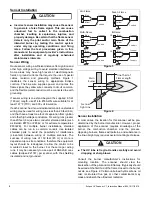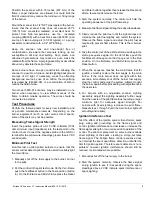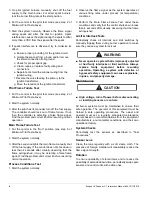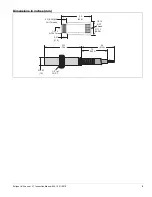
3
Eclipse UV Scanner, V1, Instruction Manual 854, 10/11/2010
Position the scanner within 18 inches (457 mm) of the
flame. Longer distances are allowed, but could limit the
field of view and may reduce the turndown or firing range
of the burner.
Mount the scanner to a 1/2" NPT pipe nipple to the burner.
Insure that the scanner body does not exceed 257°F
(125°C) from conducted, radiated, or ambient heat. To
protect from high temperatures, use the insulated
coupling (#49099) with a heat block seal (#400011) and
source of clean purging air (5 CFM typical), or a purge
assembly constructed with a 1/2" WYE fitting.
Keep the scanner lens and line-of-sight free of
contamination. Be aware that scanners looking up are
susceptible to dirt and dust settling. Soot, steam, and
unburned hydrocarbons may reduce or even mask the
radiation from the flame. A purging assembly as described
above may alleviate these problems.
Some burners have an open construction allowing the
scanner to view into a furnace. Avoid sighting background
sources of UV light. If necessary, mask the offending
background source by use of an orifice, the magnifying
lens assembly (#49600-98), or a combination of both to
reduce the field of view.
Two model 5600-91 scanners may be installed on one
burner when necessary to view different areas of the
flame to obtain reliable operation. The wires should be
connected in parallel.
Test Procedures
Perform the following tests for every new installation and
at periodic maintenance intervals. Depending on the
burner equipment (such as pilot versus direct spark),
some of the tests may not be possible.
Measuring Flame Signal Strength
Insert the positive probe of a 0-15 VDC voltmeter (100k
ohm minimum input impedance) into the test point on the
control cover. Connect the negative probe to the GND or
terminal for the yellow wire. Readings greater than 4 VDC
are adequate.
Minimum Pilot Test
Run this test on pilot ignited burners to ensure that the
sensor will not detect a pilot flame too small to reliably light
the main flame.
1. Manually shut off the fuel supply to the burner, but not
to the pilot.
2. Put the control in the pilot test mode. On the Veri-Flame
push the Test/Reset button in the Test position (button
in). On the Bi-Flame and Multi-Flame press the Reset
and Enter buttons together then release the Reset and
after a few seconds release the Enter.
3. Start the system normally. The control will hold the
operating sequence at the pilot flame step.
4. Measure the flame signal strength as described above.
5. Slowly reduce the pilot fuel until the signal drops out.
Increase the pilot fuel slightly and restart the system.
Observe the flame signal and adjust the pilot fuel as
required to prevent flame failure. This is the minimum
pilot.
6. Take the control out of the pilot test mode and begin the
start-up sequence again. On the Veri-Flame push the
Test/Reset button again so that it pops out to the Run
position. On the Bi-Flame and Multi-Flame press the
Reset button.
7. When the sequence reaches the main flame trial for
ignition, smoothly restore the fuel supply to the main
burner. If the main burner does not light within five
seconds, immediately shut off the burner fuel supply,
stop the control and purge the system. Attempt to light
the burner again before proceeding with adjustments in
the next step.
8. For burners with an adjustable scanner sighting
assembly, adjust the sighting assembly further away
from the nozzle of the pilot flame thus requiring a larger
minimum pilot for adequate signal strength. For
burners with fixed sighting, increase the pilot flame.
Repeat steps 1 through 8 until the main burner lights off
smoothly and reliably.
Ignition Interference Test
Test the effect of the ignition system (transformer, spark
plug, wiring and grounding) on the flame signal and
control. Ignition interference can decrease or increase the
flame signal strength or can cause erratic operation of the
control. The scanner placement on some burners allows
direct sighting of the spark, creating a strong but false
flame signal. The Eclipse flame control sequence does
not interrupt the spark upon flame detection until after the
trial for ignition period. Therefore spark detection is not a
problem; however ignition interference should still be
reduced or eliminated where possible.
1. Manually shut off the fuel supply to the burner.
2. Start the system normally. Observe the flame signal
during ignition to see if it responds during the spark.
Readings above 2 VDC indicate spark interference or
spark sighting.
























